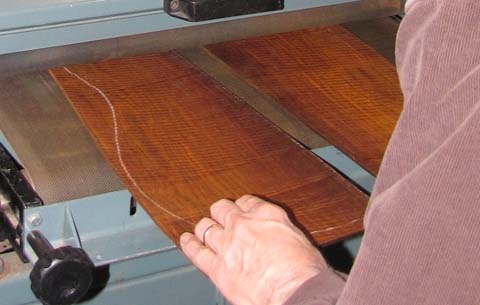A second GWND guitar
Building the first guitar was quite an enlightenment. All of a sudden, terms like scale length, nut width, saddle width, and body depth, just to mention a few, took on new meanings with new possibilities. The fact that you could build the guitar from basic pieces of wood meant you were free from the constraint of having to play what other people thought would sell.. Instead you could build one that incorporated the features that you wanted. There’s always compromise, but in the case of building a guitar, you can pick the compromises that you like. You’re much more in control of the outcome and if you don’t like something you can always build it better next time.
At the end of the first “build” (see GWND guitar on this site) I had an opportunity to buy some cocobolo wood for the back and sides of a new guitar. There were two sets of fresh new cocobolo wood that had just arrived at Dave’s shop and one of them just had to be mine. On top of that I was even given the choice of which set I wanted. Now that kind of choice is something like offering a kid a choice between two sets of candy – It’s just all good. It’s impossible to go wrong. So buy a set I did. That was in 2007.
Skip ahead to 2011 and I was down in Malone getting some help with some inlay. Dave showed me some really nice spruce tops that had recently arrived, and he was quite pleased with them. Basically he had a whole pile of exceptionally good wood, and now would be a good time to choose what I wanted from it. That kind of triggered the idea of finally starting on a second guitar, so I bought a really nice set of top halves and committed to building a second guitar soon. This time I knew more about what I wanted.
I wanted it to have a cutaway; unfortunately Dave was not impressed with that choice. Cutaways can be a nightmare, with wood cracking, especially cocobolo. Sharp curves can be murder to bend, physically hard on the person shaping the wood, and of course Dave’s philosophy of not letting a student screw up meant the he, Dave, would be doing the bending. But I really wanted one, and in the end Dave pointed to a photo on the wall and said that if we were going to do a cutaway, that was the only style of cutaway that he’d be willing to consider – a Florentine cutaway was quite acceptable, thank you.
Also, I wanted lots of inlay – the more the merrier, and in that I could participate fully. I had a “tree of life” fretboard plus a headstock already inlaid, and some ideas for other bits of inlay.
One other item was that I wanted a slightly wider than standard neck. The standard loosely seems to be a nut width of 1 11/16″ with a saddle with of 2 1/8″. I wanted mine to be a bit wider with a nut width of 1 3/4″ and a saddle width of 2 1/4″. Apparently this was quite possible, so with those parameters in mind I started on the second GWND guitar in March of 2011. (see the link to the GWND on the side of the home page of this site)

